TIZ 6. Planet A: Green World
![Alan Sekula, Volunteer on the edge (Islas Cíes, 12/20/02) [Voluntario en la orilla (Islas Cíes, 12/20/02)], 2002. Museo Reina Sofía](https://recursos.museoreinasofia.es/styles/large_landscape/public/Actividades/zit_6.jpg.webp)
Held on 01 Oct 2022
Do we unhurriedly turn a blind eye even when the consequences of climate change are becoming increasingly more apparent? The disappearance of major ecosystems, the most dramatic environmental changes and the depletion of fossil fuels condemn the current economic model to collapse. Yet, opposite this all-encompassing apocalyptic landscape stands the possibility of collectively rethinking the future. This entails new ways of relating to others, to time, to death, and to art; that is, new definitions of the human and other forms of life that go beyond the logics of extraction and waste. Thus, twenty years on from the sinking of the Prestige, this Temporary Intensity Zone calls upon the collective potential of a self-organised citizenry facing the life-threatening side of environmental disaster. Yet how is a (social) climate organised? The imaginative, documentary, emancipatory, communicative and historical possibilities of artistic forms are not only vital tools when it comes to building this new future ecology. Today, they are materially inseparable from their nature and are no longer a counter-shape of art but rather the political matter of common work to reproduce life.
-
Friday, 11 November 2022 Nouvel Building, Auditorium 200
Collective Mourning and Planetary Mourning. MONUMENT 0.6: Heterochrony
Eszter Salamon
TicketsThe Museo organises Collective Mourning and Planetary Mourning, with a live arts programme which participates in the 40th Autumn Festival of Madrid. The first part features the performance of MONUMENT 0.6: Heterochrony, a stage piece by Hungarian choreographer Eszter Salamon, who creates an imaginary scene between past and present. The work also includes echoes of music archives from Sicily with choreographic impressions inspired by the mummification rituals of the Capuchin Catacombs of Palermo, presenting a continuum between life and death, a phantasmagorical co-existence, while inventing its own utopian body: a dancing, acoustic body. The performance is followed by a conversation between Eszter Salamon, Isabel de Naverán, Germán Labrador and Alberto Conejero.

-
Saturday, 12, and Sunday, 13 November 2022 Sabatini Building, Floor 1, Room 102
Collective Mourning and Planetary Mourning. Unending love, or love dies, on repeat like it's endless
Alex Baczyński-Jenkins
TicketsThe second part of the Collective Mourning and Planetary Mourning programme presents the performance Unending love or love dies, on repeat like it's endless, a choreography by Alex Baczyński-Jenkins which explores relationships between desire, dance, fragmentation, love (understood as communality), mourning and time. Through the gesture, sensuality, relationality and touch, Baczyński-Jenkins’s practice unfurls structures and politics of desire. Relationality is present in the dialogic forms of developing and performing the piece, and in the materials and poetics it invokes. This includes the study of the relationships between feeling and sociability, embodied expression and alienation, the textures of daily experiences and latent queer utopian legacies.

-
From 16 to 19 November 2022
Tides and Disasters
Critical Ecologies Encounter
As the sinking of the Prestige off the Galician coast in 2002 demonstrated, most contemporary environmental disasters have given rise to significant mobilisations of mutual aid and demands in the places where they occur. In this encounter, different researchers, artists, activists and citizens reflect on the relations between ecology, memory and democracy today. The programme revolves around four axes: environmental traditions stretching from the anti-Francoist struggle to the present; memory and citizen creativity following the Prestige oil spill; authoritarian threats that loom from the depletion of fossil fuels; and controversies around imaginable futures.
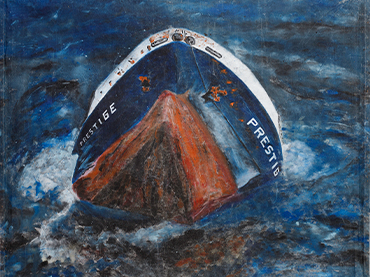
-
Friday, 18, and Saturday, 19 November 2022
Capitalocene Utopias
Eco-social Crisis: Definitions, Strategies and Strategic Proposals
Rising inflation, a dearth of resources, armed conflicts and alarming high temperature warnings, among numerous other issues, show that the environmental crisis is not simply a partial problem considered and resolved exclusively from environmental sectors. It concerns a systemic crisis that affects the entire social and organisational order, including a capitalist system that does not provide us with a viable response. As a coda to the course The Future is Unwritten, organised by Fundación de los Comunes (the Commons Foundation), the Museo welcomes this open encounter which prompts a collective evaluation of forms of organisation and the political strategies applied to date.
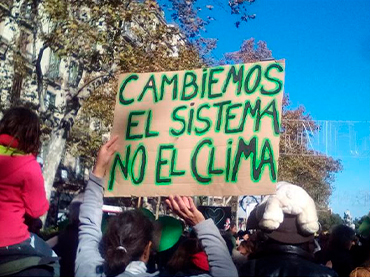
-
Tuesday, 29 November 2022 Meeting Point: Sabatini Building, Floor 1, Room 103.00
Free Unions. Rosa Barba: Machine Murmur
Activities on the Collection
RegistrationThe programme Free Unions is structured around a series of events, surveys and activations in the rooms of Communicating Vessels. Collection 1881–2021, the new rehang of the Museo Reina Sofía Collection. This particular edition activates Rosa Barba’s work Bending to Earth (2015), a 35mm film installation which explores nuclear waste and the way in which it radically transforms the landscape. The encounter continues with a conversation with the artists and concludes with the live presentation of Wirepiece (2022), a machined concert played with a drum string, a strip of film and a modified 16mm projector.
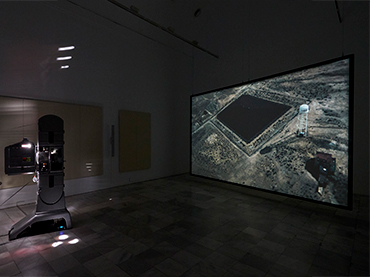
-
13 April – 25 May 2023
When Destiny Catches Up with Us
Desperate Actions Before the Sixth Extinction
Tickets (13 April)When Destiny Catches Up with Us addresses the contributions of popular knowledge and scientific research on the extinction of animals that are key to the biosphere and are often found outside the scope of human perception. Therefore, it sets forth different sessions with talks and concerts that explore in more depth the problem of mass extinction, looking at the disappearance of bees and microorganisms from the ocean. The title of the activity is a translation of the Spanish translation of the film Soylent Green (1973), directed by American film-maker Richard Fleischer.

-
20 December 2022 - 26 January 2023
Collective Mourning and Planetary Mourning
Study Group
RegistrationThis study group ties in with the same-titled live arts programme. Across six sessions, artists and researchers share their investigations, readings, experiences and artistic references, contributing to an enrichment of reflections and debates which set up a dialogue with mourning a process of human loss and the mourning engendered by the gradual destruction of the planet. In this context of social disturbance, forms of rituality and collective care arise, inviting us to reflect on the potential of mourning to reshape relationships with the world.
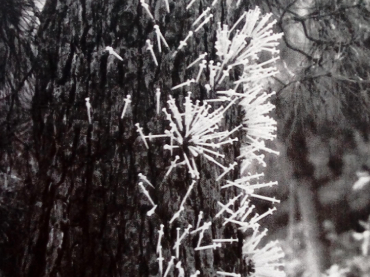
-
Episode 3. Campo Cerrado Sabatini Building, Floor 4
A Modern Bid for New Social Housing. Room 400.03
This room explores the modernisation programme of Francoist Spain in the 1940s and 1950s. Leaving behind the Republican project of land distribution, attempts at creating land were only made possible with irrigation fed by reservoirs. Yet this policy would not manage to avoid mass rural exodus that emptied the countryside and filled cities like Madrid. The Regime looked to symbolically compensate for this rural migration through new towns, some of which appear photographed in this room. As a counterpoint to the extractivist gaze that still prevails today, the space also features the works of Josep Guinovart, who still imagined the possibility of a good life in the country.
-
Episode 7. Apparatus ‘92. Can History Be Rewound? Sabatini Building, Floor 0
8° C Less. Architecture and Climate at Expo '92. Room 002.04
The Universal Exhibition of Seville showed a side to bioclimatic architecture which, in this instance, did not involve devising structures to make use of the possibilities of the natural environment, but instead took plants from their ecosystems to adapt them to ephemeral designs made from scratch. Once such example was the huge cactus in the Mexican Pavilion, which was transported free of soil, mirroring its appearance in European botanical books and contrasting sharply with indigenous codices, whereby each plant was represented with its soil, wildlife and even its associated oral culture. The essay Cardón cardinal (Cardinal Cardon, 2020), along with other works that include scale models and plans of Expo, expose this contrast between the individualising epistemology of European modernity and that which made visible our current notions of ecosystems.
-
Episode 7. Apparatus ‘92. Can History Be Rewound? Sabatini Building, Floor 0
Liliana Maresca: El Dorado, 1991. Room 002.07
The emphasis the conquest of the Americas placed on obtaining precious metals forged an extractivist epoch which stretches right up to our own era, along with the environmental and human effects. In this room, the sculptures show a computer printout: the results of an equation devised to calculate the relationship between kilos of gold transported from the Americas and the litres of Indian blood shed there during the Conquista. Opposite, an armchair symbolises colonial power, in adulation of gold like a god. Only through this divinization could the natives explain, according to Liliana Maresca, the conquistadors’ thirst for gold above all other considerations. In order to understand the whole life of a territory as a resource for a greater end, this end must be something supernatural and all-powerful.
-
Episode 7. Apparatus ‘92. Can History Be Rewound? Sabatini Building, Floor 0
The Potosí Principle. Room 002.08
The beginnings of the current destruction of life involving an economic model based on the extraction of metals and fuel stretch back to the Potosí mines. The works in this room show the culture of violence that had to be unleashed to make exploitation possible: the iconography of arquebusier angels or the adaptation of Saint James Matamoros, not so far away from the violence against farmers already taking place in Europe in this period and echoed even by Dürer. Such phenomena can be seen in the research and documents compiled in the major exhibition Potosí Principle. How Shall We Sing the Lord’s Song in a Strange Land?, held inside the Museo in 2010, and of which this room is at once a sample and a homage. In addition, there are also visual documents and graffiti against the domestic exploitation of women, which even today is disguised within a neo-colonial social structure.
-
Episode 7. Apparatus ‘92. Can History Be Rewound? Sabatini Building, Floor 0
Another Possible World. Room 002.13
This room assembles examples of the way of life, organisation and expression of Zapatista peoples in Chiapas, as well as their will to be open to the outside, demonstrated by the global tour of listening and knowledge transfer they embarked upon in 2021, also embraced by the Museo. The different pieces show not only a people living from agro-ecological farming, but also the political and cultural conditions which allow them to move away from global extractivism: from the principles of good governance (“lead by obeying”, “Go down, not up”, “convince, don’t defeat”, “propose, don’t impose”) in an awareness of the non-separation between nature and culture, between art and technique.
-
Episode 8. Exodus and Communal Life Sabatini Building, Floor 1
Black Tide. Room 103.01
In 2002, the Prestige oil tanker spilled 77,000 tons of fuel oil, which reached the Cantabrian coast. Some 100,000 volunteers came together, organising spontaneously and effectively to clean up the coast, beyond the possibilities of public administrations. Photographer Allan Sekula documents this mobilisation in the series Black Tide (2002), which also lends this room its title. In parallel, a protest mobilisation also materialised, along with major cultural production, part of which is shown here from the archive of the Unha Gran Burla Negra (A Great Black Mockery) cultural association. These protests and proposals have been seen as a precedent for other social and cultural movements both inside and outside Galicia.
-
Episode 8. Exodus and Communal Life Sabatini Building, Floor 1
Wang Bing: Crude oil, 2008. Room 103.05
In his documentary Crude oil (2008), film-maker Wang Bing shows China’s growing economic dependency on petroleum and the effects of the petrol industry on the globalised world. In a mammoth fourteen-hour-long film, Bing records the working day on an oil field in an expanding mining area, introducing us, almost clandestinely, to the private life of the people in front of the camera as they discuss politics and corruption and binge-watch TV series. These shots combine with sequences of the infrastructure, the machinery and the devastated landscape of the site.
-
Episode 8. Exodus and Communal Life Sabatini Building, Floor 1
Marcel Dzama and Raymond Pettibon. The Great Wave. Room 103.09
The entire focus of this room is the large-scale work on paper It Is Big Big Business (2016) by Canadian artists Raymond Pettibon and Marcel Dzama. With a style combining proximity to popular culture and a penchant for attention to detail and slow time, both creators combine super heroes, surfers, allusions to police violence and, first and foremost, their main reference: the natural imbalance stemming from a world underpinned by fossil-fuel extractivism.
-
Episode 8. Exodus and Communal Life Sabatini Building, Floor 1
Rosa Barba: Bending to Earth, 2015. Room 103.11
In Bending to Earth (2015), Rosa Barba centres on the places which store radioactive waste to reflect upon the human footprint and its prolonged ramifications. She shows us, on a hand-held camera from a helicopter, the mysterious structures built for the long-term storage of radioactive waste in the desert zones of California, Utah and Colorado, examples of landscapes radically transformed by centuries. Moreover, the room shines a light on a system of looped filming developed to ensure the film is presented as an endless loop. This film equipment lends an in-person and sculptural quality to the work, adding physicality to the intangible of the film image comprised of light, shade and time.
-
Episode 8. Exodus and Communal Life Sabatini Building, Floor 1
Angela Melitopoulos: Cruces, 2017. Room 103.12
Crossings (2017) is a video installation which shows the social and psychological impact of the 2008 Great Recession in Greece. Melitopoulos bears witness to the impossibility of coordinating and collaborating between an abstract world of financial capital and the concrete reality of people and nature, while the accounts and images captured also suggest that the contradictions of the current world can engender new subjectivities, and thus possibilities for forms of resistance and change.
-
Together and Rising Up
EXHIBITIONS
-
11 November, 2022 – 10 February, 2023 Nouvel Building, Library and Documentation Centre, Space D
Cards on the Table
The memory of Nunca Máis and the stacked political cards
19 November 2022 marked twenty years since the Prestige oil tanker sank off the Galician coast, followed by an emphatic citizen response to the sorely deficient management of the crisis. In the face of such an anniversary, the association Unha Gran Burla Negra (A Great Black Mockery) sought to recall, investigate, disseminate and reactivate the popular memory of these events through an editorial and exhibition project, producing O Ghaiteiro Petroleiro (The Bagpiping Tanker, 2022) an artistic pack of cards which satirically combines memories of the Nunca Máis (Never Again) movement and popular imagery of Galicia. To contextualise the project, the room displays other series of playing cards linked by struggle and protest.
![Platform against A Burla Negra [The Black Mockery]. Ace of Cups from A baralla do Prestige [The Prestige Pack], 2002 Platform against A Burla Negra [The Black Mockery]. Ace of Cups from A baralla do Prestige [The Prestige Pack], 2002](https://recursos.museoreinasofia.es/legacy_programs/cartas_snippet_2_0.jpg)
-
16 November 2022 - 27 February 2023 Sabatini Building, Floor 3
Documentary Genealogies
Photography, 1848–1917
TicketsThis exhibition presents a cartography of practices related to the appearance and evolution of representations of subaltern identities — workers, servants, proletarians, beggars, the deprived — stretching from the rise of photography to the turn of the twentieth century (more specifically, between the revolutions of 1848 and the Russian Revolution in 1917). Thus, the photographs on show reveal the social consequences of fossil-fuel extractivism during the era of the great expansion, the time of the black world of coal.
-
24 November 2022 - 17 April 2023 Sabatini Building, Floor 3
Margarita Azurdia
Margarita Rita Rica Dinamita
TicketsMargarita Rita Rica Dinamita is the first European retrospective devoted to Margarita Azurdia, one of the twentieth century’s most emblematic Central American artists. The survey delves into her career, journeying through her vast output, which spans painting, sculpture, non-objectual art and artist’s books drafted with drawings, collages and poems. Retrospectively, it opens an in-depth view of the modern and contemporary art landscape and prompts an exploration of the artist’s creative metamorphosis which led her to examine the paradigm between art and spirit, investigating in greater depth ideas of care and healing linked to nature and the environment.
-
Online publication
Climate: Our Right to Breath
Hiuwai Chu, Meagan Down, Nkule Mabaso, Pablo Martínez and Corina Oprea (eds.)
This anthology by L’Internationale seeks to respond to two key and mutually exacerbating planetary conditions: the accelerated collapse of the biosphere under climate change and the increasingly more devastating dynamics of toxic politics. Yet the reactionary, divisionary politics driven by ruthless forms of authoritarianism, denialism, nationalism, and other globalized forms of oppression are also a call to action. The book incorporates over twenty-five voices from the arts and culture to form an internationalist chorus that responds to a collective need to develop common strategies for solidarity in the face of ecological disaster and which support the most vulnerable and marginalised communities in this racialised capitalism.
-
Podcast
Susan Schuppli
Playing Back the Histories of Climate Change
Listen to the podcastSusan Schuppli is an artist and researcher who lives in the UK, her work examining the material proof of conflicts and environmental disasters. In her practice, she looks to join creativity and science, and through this sound essay she explores the concept of “indirect data”, exposing how to help creative projects produce serious and consequential environmental knowledge around the world we inhabit. She upholds that cultural and historical materials can provide insights about weather and atmospheric chemistry, data which requires complex processes of evaluation and empirical assessment so they can be incorporated into simulations of global climate models with a will to be constructed from the field of science.
-
Podcast
Burrow Collective
In the Eye of the Storm
Listen to the podcastIn the Eye of the Storm weaves together multiple stories and voices recounting the aftermath of Cyclone Winston, a super cyclone that hit Fiji in 2016. This climatic event was historically the most intense cyclone recorded in the Southern Hemisphere, causing hundreds of thousands of people to be displaced and dozens of lives to be lost. Its repercussions are still felt today. Written and performed by four spoken word poets, writers and scientists, and narrated through the retellings of a geolinguist, In the Eye of the Storm links together the lived and witnessed experiences of environmental catastrophe with the colonial dispossession brought about by, and reiterated through, the ongoing violence of empire.
Más actividades

Difficulty. Forms and Political Effects of Deviation in Writing and Contemporary Art
23 February – 14 December 2026 – Check programme
Difficulty. Forms and Political Effects of Deviation in Writing and Contemporary Art is a study group aligned towards thinking about how certain contemporary artistic and cultural practices resist the referentiality that dominates the logics of production and the consumption of present-day art. At the centre of this proposal are the concepts of difficulty and deviation, under which it brings together any procedure capable of preventing artistic forms from being absorbed by a meaning that appears previous to and independent from its expression. By ensuring the perceptibility of their languages, difficulty invites us to think of meaning as the effect of a signifying tension; that is, as a productive and creative activity which, from the materiality of art objects, frees aesthetic experience from the representational mandate and those who participate in it from the passiveness associated with tasks of mimesis and decoding.
The economy of the referential norm translates the social logic of capitalism, where insidious forms of capturing subjectivity and meaning operate. In the early 1980s, and adopting a Marxist framework, poet Ron Silliman highlighted how this logic entailed separating language from any mark, gesture, script, form or syntax that might link it to the conditions of its production, rendering it fetichised (as if without a subject) and alienating its users in a use for which they are not responsible. This double dispossession encodes the political strategy of referential objectivity: with no subject and no trace of its own consistency, language is merely an object, that reality in which it disappears.
The political uses of referentiality, more sophisticated today than ever before, sustain the neoliberal-extractivist phase of capitalism that crosses through present-day societies politically, economically and aesthetically. Against them, fugitive artistic practices emerge which, drawing from Black and Queer studies and other subaltern critical positions, reject the objective limits of what exists, invent forms to name what lies outside what has already been named, and return to subjects the capacity to participate in processes of emission and interpretation.
Read from the standpoint of artistic work, the objective capture of referentiality may be called transparency. Viewed from a social contract that reproduces inequality in fixed identity positions, transparent in this objectivity are, precisely, the discourses that maintain the status quo of domination. Opposite the inferno of these discourses, this group aims to collectively explore, through deviant or fugitive works, the paradise of language that Monique Wittig encountered in the estranged practices of literature. For the political potency of difficulty — that is, its contribution to the utopia of a free language among equals — depends on making visible, first, its own deviations; from there, the norm that those deviations transgress; and finally, the narrowness of a norm which in no way exhausts the possibilities ofsaying, signifying, referring and producing a world.
From this denouncement of referential alienation, fetishisation and capture, Difficulty. Forms and Political Effects of Deviation in Writing and Contemporary Art turns its attention to the strategies of resistance deployed by contemporary artists and poets. Its interest is directed towards proposals as evidently difficult or evasive as those of Gertrude Stein, Lyn Hejinian, Theresa Hak Kyung Cha, Kameelah Janan Rasheed, Kathy Acker, María Salgado and Ricardo Carreira, and as seemingly simple as those of Fernanda Laguna, Felix Gonzalez Torres and Cecilia Vicuña, among other examples that can be added according to the desires and dynamics of the group.
The ten study group sessions, held between February and December, combine theoretical seminars, work with artworks from the Museo Reina Sofía’s Collections and exhibitions, reading workshops and public programs. All these formats serve as spaces of encounter to think commonly about certain problems of poetics — that is, certain political questions — of contemporary writing and art.
Difficulty. Forms and Political Effects of Deviation in Writing and Contemporary Art inaugurates the research line Goodbye, Representation, through which the Museo Reina Sofía’s Studies Directorship seeks to explore the emergence of contemporary artistic and cultural practices which move away from representation as a dominant aesthetic-political strategy and redirect their attention toward artistic languages that question the tendency to point, name and fix, advocating instead for fugitive aesthetics. Over its three-year duration, this research line materializes in study groups, seminars, screenings and other forms of public programming.

CLINIC 2628. A Community of Writing and Research in the Arts
February – October 2026
Clinic 2628 is a project which supports and brings together writings which stem from the intention to offer a space and sustainable time for research work in art and culture. Framed within an academic context which is increasingly less receptive to the forms in which thinking happens and is expressed, the aim is to rescue the academic from its neoliberal trappings and thus recover the alliance between precision and intuition, work and desire. A further goal is to return writing to a commons which makes this possible through the monitoring of processes and the collectivisation of ideas, stances, references and strategies.
The endeavour, rooted in a collaboration between the Museo Reina Sofía’s Studies Directorship and the Artea research group, via the i+D Experimenta project, is shaped by three annual editions conceived as spaces of experimentation, discussion and a demonstration of writings critical of what is put forward by today’s academia.
What forces, forms and processes are at play when writing about art and aesthetics? In academia, in museums and in other cultural institutions, the practice of writing is traversed by productivist logics which jeopardise rhythms of research and experimentation. The imposition of both scientism inherent in the structure of “the paper” and the quantifying of results which demand a criterion of quality and visibility sterilise and smoothen, from the outset, the coarseness that is particular to writing understood from the concrete part of language: phonic, graphic, syntactic and grammatical resistance connecting the language user to the community the language unites and activates. They also sterilise the roughness enmeshed in the same desire to write, the intuitive, clear and confusing pathways that once again connect the writer to those reading and writing, participating in a common good that is at once discovered and produced.
The progressive commercialisation of knowledge propelled by cognitive capitalism moves further away from the research and production of knowledge in artworks and artistic languages and practices. The work of curators and archive, criticism, performances and essays formerly saw a horizon of formal and emotional possibilities, of imagination that was much broader when not developed in circumstances of competition, indexing and impact. Today, would it be possible to regain, critically not nostalgically, these ways; namely, recovering by forms, and by written forms, the proximity between art thinking and its objects? How to write in another way, to another rhythm, with no more demands than those with which an artwork moves towards different ways of seeing, reading and being in the world?
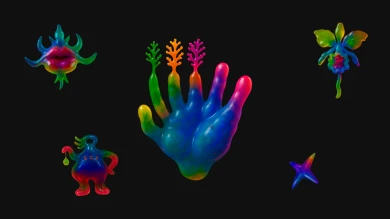
Cultural Work
Thursday, 12 February 2026 – 5:30pm
This series is organised by equipoMotor, a group of teenagers, young people and older people who have participated in the Museo Reina Sofía’s previous community education projects, and is structured around four themed blocks that pivot on the monstrous.
Session number two looks to approach film as a place from which cultural work is made visible and processes of production engage in dialogue with artistic creation. From this premise, the session focuses on exploring how audiovisual content is produced, assembled and distributed, from the hands that handle the images to the bodies that participate in its circulation. The aim is to reflect on the invisible effort, precarity and forms of collaboration that uphold cultural life, that transform the filmic experience into an act that recognises and cares for common work.
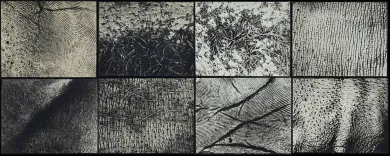
The (legal) person and the legal form. Chapter II
8, 12, 15 January, 2026 – 16:00 to 19:00
As part of the Studies Constellation, the Study Directoship’s annual fellowship, art historian and theorist Sven Lütticken leads the seminar The (Legal) Person and the Legal Form: Theoretical, Artistic, and Activist Commitments to foster dialogue and deepen the hypotheses and questions driving his research project.
This project, titled Unacting Personhood, Deforming Legal Abstraction, explores the dominance of real abstractions—such as exchange value and legal form—over our processes of subjectivation, and asks how artistic practices can open up alternative ways of representing or performing the subject and their legal condition in the contemporary world.
The seminar consists of eight sessions, divided into three chapters throughout the academic year. While conceived as non-public spaces for discussion and collective work, these sessions complement, nourish, and amplify the public program of the Studies Constellation.
In this second chapter of the seminar, the inquiry into the aesthetics and politics of legal form continues with three sessions that pick up the discussions held in Chapter I but propose new lines of flight. The first session focuses on international law via the writings of the British author China Miéville, which allows us to reconsider the notion of the legal form –following Evgeny Pashukanis— and, through it, a variety of (people’s) tribunals. While the crucial concept of the legal person –as the right-holder central to the form of law— was debated in Chapter I, the second session focuses on attempts to extend personhood not (just) to corporations, but rather to nonhuman animals or ecosystems. Finally, the third session poses the question: how can groups and networks use officially recognized organizational forms (such as the foundation or the cooperative) and/or use a collective persona (without necessarily a legal “infrastructure” to match) to act and represent themselves?

TEJA 2026. Open Call for Emergency Art Residencies
Proposal submission until 12 January, 2026
TEJA / Red de espacios culturales en apoyo a situaciones de emergencia [Network of Cultural Spaces in Support of Emergency Situations] has the mission to promote transnational cooperation by offering temporary art residencies to artists and cultural practitioners who find themselves in complex socio-political situations in their countries of origin. During their stay in Spain, residents receive accommodation, legal and psychological counseling, and access to a network of organizations and professionals with whom they can share, develop, and continue with their creative projects. The goal is to provide a safe and stimulating environment where artists can continue their work despite adverse circumstances and generate dialogue spaces that ensure freedom of expression through joint activities both in Spain and with international collaborators.
During 2026, TEJA hosts three new residencies, each lasting three months, dedicated to supporting artists and cultural practitioners residing in the West Bank and Jerusalem. In addition, in the second half of the year, TEJA hosts three additional residencies for Gazan artists, which are offered by invitation (as Spain is currently unable to facilitate evacuations from Gaza, these invitations are coordinated through France). These residencies aim to provide a stable, creative environment and foster artistic exchange in the face of ongoing adversities. Through this new program, TEJA reaffirms its commitment to amplifying Palestinian voices and empowering artists as they navigate these turbulent times.
The selection is carried out by the TEJA network in close collaboration with each hosting partner. This year the hosting partners are: La Escocesa (Barcelona), hablarenarte / Planta Alta (Madrid), Espositivo (Madrid), Institute for Postnatural Studies (Madrid), Casa Árabe (Córdoba). The selection prioritizes the artist’s personal and professional situation first, and then the alignment with the practices and themes of the hosting spaces. Proposal submission deadline is January 12th, 2026, 23:59 h.
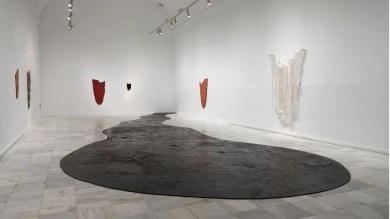
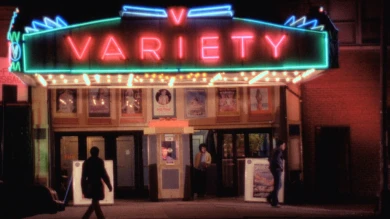
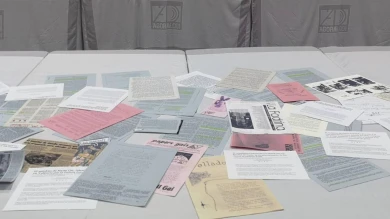
![Miguel Brieva, ilustración de la novela infantil Manuela y los Cakirukos (Reservoir Books, 2022) [izquierda] y Cibeles no conduzcas, 2023 [derecha]. Cortesía del artista](https://recursos.museoreinasofia.es/styles/small_landscape/public/Actividades/ecologias_del_deseo_utopico.jpg.webp)
![Ángel Alonso, Charbon [Carbón], 1964. Museo Reina Sofía](https://recursos.museoreinasofia.es/styles/small_landscape/public/Actividades/perspectivas_ecoambientales.jpg.webp)